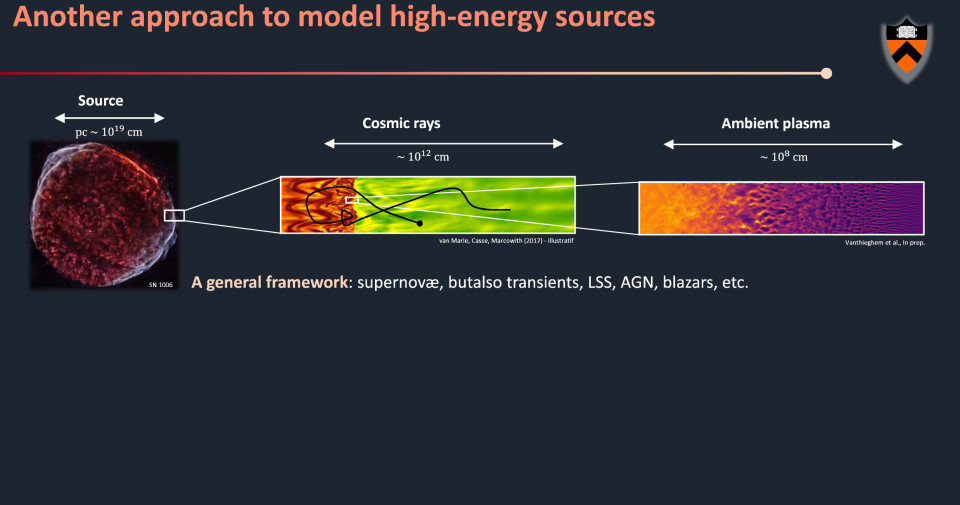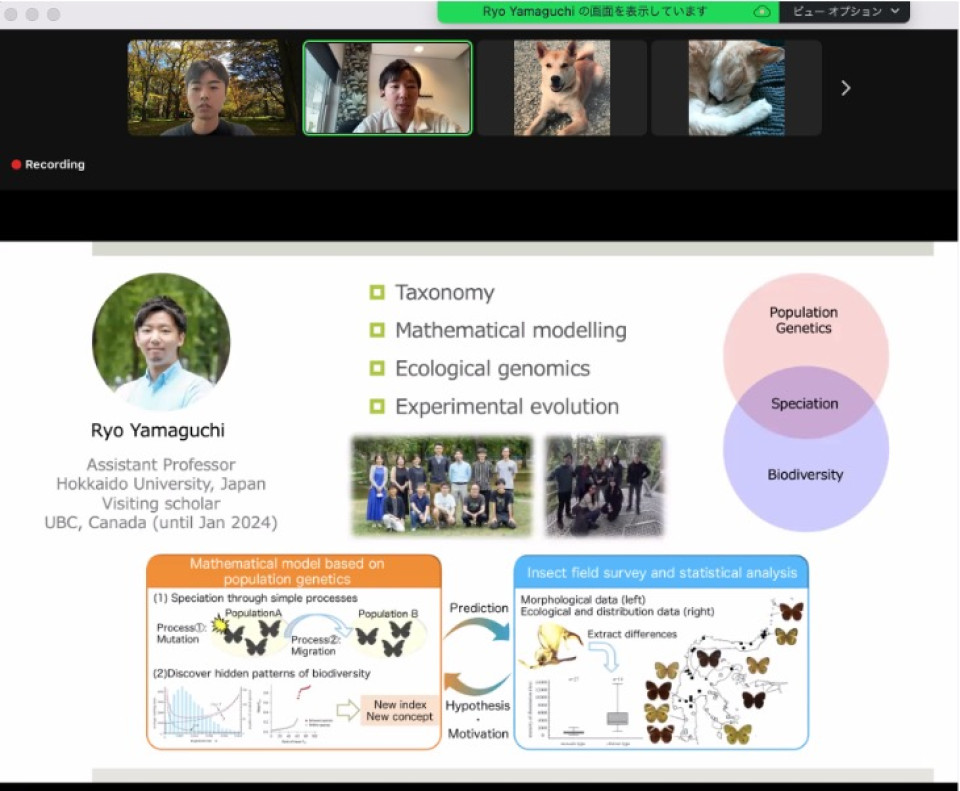Volume 270
Back to Newsletter List
Seminar Report
ABBL-iTHEMS Joint Astro Seminar by Arno Vanthieghem on September 8, 2023
2023-09-27
Relativistic radiation-mediated shocks (RRMS) dictate the early emission in numerous transient sources such as supernovae, low luminosity gamma-ray bursts, binary neutron star mergers, and tidal disruption events. These shock waves are mediated by Compton scattering and copious electron-positron pair creation. It has been pointed out that a high pair multiplicity inside the shock transition leads to a lepton-baryon velocity separation, prone to plasma instabilities. The interaction of the different species with this radiation-mediated microturbulence can lead to coupling and heating that is unaccounted for by current single-fluid models. Arno presented a theoretical analysis of the hierarchy of plasma microinstabilities growing in an electron-ion plasma loaded with pairs and subject to a radiation force. His results are validated by particle-in-cell simulations that probe the nonlinear regime of the instabilities and the lepton-baryon coupling in the microturbulent electromagnetic field. Based on this analysis, he derived a reduced transport equation for the particles that demonstrates anomalous coupling of the species and heating in a Joule-like process by the joined contributions of the decelerating turbulence, radiation force, and electrostatic field. Arno then discussed the effect of finite magnetization on the general dynamics and recent efforts toward a more self-consistent description of the coupling. In general, his results suggest that radiation-mediated microturbulence could have important consequences for the radiative signatures of RRMS.
Reported by Shigehiro Nagataki
Collective Plasma Effects in Relativistic Radiation-Mediated Blast Waves
September 8 (Fri) 14:00 - 15:15, 2023
Seminar Report
iTHEMS Biology Seminar by Ryo Yamaguchi on June 8, 2023
2023-09-26
During this session, Dr. Yamaguchi delivered a lecture on evolutionary ecology and its theoretical aspects. He is a researcher who has successfully discovered and quantified new biodiversity patterns through mathematical models in population genetics. In this presentation, he explained his recent research findings in a way that even beginners could easily understand. Various questions and discussions took place.
Particularly noteworthy was the high compatibility of his expertise in insects and yeast with other biological fields, allowing for exchanges of ideas with various researchers. My own area of expertise lies in microbiology, specifically in bacteria. While his models primarily focus on eukaryotic organisms, direct application may be challenging, but applying his concepts is feasible. Applying these concepts is likely to yield new insights into the heterogeneity of populations in microbiology.
In conclusion, this presentation provided a valuable platform for active discussions among researchers from diverse biological disciplines, making it a highly meaningful session.
Reported by Daiki Kumakura
Deciphering speciation processes: a mathematical modelling approach to biodiversity patterns
June 8 (Thu) 10:00 - 11:00, 2023
Upcoming Events
Seminar
iTHEMS Math Seminar
Interactions between Algebraic Topology and Representation Theory by Toric Code
October 2 (Mon) - 4 (Wed) 2023
Minkyu Kim (Research Fellow, School of Mathematics, Korea Institute for Advanced Study (KIAS), Republic of Korea)
Toric code is an error correction code designed by Kitaev in late 1990’s, which contributes to the birth of topological quantum computation. The goal of these lectures is to introduce toric code and related mathematics. We will explain an interaction between low-dimensional topology and representation of Drinfeld double. Especially, we will encode several operations (e.g. braidings) on representations into topology and geometry on surfaces. If time allows, we will give an overview of how toric code arises from chain complexes, which will be the prequel of our talk at Tokyo-Seoul Conference on Oct 6.
These lectures will be fundamental and concrete. We hope that the audience are familiar with basic concepts of finite groups and Hopf algebras.
These lectures will be held from Oct 2 to Oct 4, each from 13:30 to 15:00, for a total of 3 lectures.
Oct 2 (mon) Introduction to toric code.
Oct 3 (tue) Introduction to non-abelian toric code.
Oct 4 (wed) Further studies on toric code.
References
- Minkyu Kim, Lecture Notes
- Minkyu Kim, Slides (Day 1)
- Minkyu Kim, Slides (Day 2)
Venue: via Zoom / Seminar Room #359, 3F Main Research Building, RIKEN
Event Official Language: English
Seminar
iTHEMS Biology Seminar
How is host-symbiont specificity determined? ---Host’s partner-choice mechanisms and symbiont’s motility
October 3 (Tue) 16:00 - 17:00, 2023
Yoshitomo Kikuchi (Group Leader, Environmental Biofunction Research Group, National Institute of Advanced Industrial Science and Technology (AIST))
Microbial symbiosis is omnipresent in animals and plants, playing a crucial role in the evolution of these organisms. While some organisms have developed mechanisms for vertical symbiont transmission, in most cases, these microbial partners are acquired from the surrounding environment, where the enormously diverse microorganisms inhabit. How, then, do these hosts ensure specificity with their symbiotic partners among such diverse environmental microorganisms? And how has this host-symbiont specificity evolved? We are addressing these questions using the bean bug Riptortus pedestris as our model. The insect acquires Caballeronia insecticola from the soil and symbioses with it in the gut crypts. Recently, we revealed that the entrance to the gut symbiotic organ is a narrow tube, just a few micrometers in diameter, filled with a mucus-like matrix. This constricted region helps the host insect select the symbiotic bacterium from the many other soil microbes. Notably, to pass through the constricted region, Caballeronia shows a unique motility called “drill motility”, where the bacterium wraps its flagella around its body. In this presentation, I will introduce the evolutionary process of both host insects and symbiotic bacteria and will discuss the pivotal role played by bacterial motility in the context of host-symbiont specificity.
Venue: via Zoom
Event Official Language: English
Seminar
ABBL-iTHEMS Joint Astro Seminar
Progenitors and Explosion Properties of Supernova Remnants Hosting Central Compact Objects
October 6 (Fri) 10:00 - 11:30, 2023
Chelsea Braun (Ph.D. Student, Department of Physics and Astronomy, University of Manitoba, Canada)
Presented is a systematic, global study of Galactic supernova remnants (SNRs) hosting Central Compact Objects (CCOs) aimed at addressing their explosion properties and supernova progenitors. With the Chandra and XMM-Newton telescopes, a spatially resolved X-ray spectroscopy study is performed on seven SNRs that show evidence of shock-heated ejecta. Using an algorithm, we segmented each SNR in the sample into regions of similar surface brightness. These regions were fit with one- or two-component plasma shock model(s) in order to separate the forward-shocked interstellar medium from the reverse shock-heated ejecta which peak in the X-ray bands for elements including O, Ne, Mg, Si, S, Ar, Ca, and Fe. We subsequently derived the explosion properties for each SNR in the sample and found overall low explosion energies (<10^51 erg). To address their progenitor mass, we compare the measured abundances from our spectroscopic modelling to five of the most widely used explosion models and a relatively new electron-capture supernova model. Additionally, we explore degeneracy in the explosion energy and its effects on the progenitor mass estimates. However, no explosion models match all of the measured ejecta abundances for any of the SNRs in our sample. Therefore, we present our best progenitor mass estimates and find overall low progenitor masses (<=25 solar masses) and we highlight the discrepancies between the observed data and the theoretical explosion models.
Venue: via Zoom
Event Official Language: English
Seminar
ABBL-iTHEMS Joint Astro Seminar
Neutrino production in AGN cores: Constraints from Kinetic Plasma Simulations
October 6 (Fri) 14:00 - 15:15, 2023
Amir Levinson (Professor, Tel Aviv University, Israel)
Accreting black holes power a variety of high-energy astrophysical systems. The activation and mode of operation of these engines has been subject of intensive research. In recent years the structure of the multi-flow emanating from the putative, giant black hole in the M87 galaxy was probed down to near horizon scales in unprecedented detail, shedding new light on the physics of accretion and the processes responsible for the formation and dissipation of relativistic jets by the black hole. I shall review recent progress in observational and theoretical studies of accreting black hole engines.
Venue: Seminar Room #359, 3F Main Research Building, RIKEN / via Zoom
Event Official Language: English
Seminar
iTHEMS Biology Seminar
Population genetics in microchannels
October 17 (Tue) 16:00 - 17:00, 2023
Anzhelika Koldaeva (Postdoctoral Researcher, Biological Complexity Unit, Okinawa Institute of Science and Technology Graduate University (OIST))
Spatial constraints, such as rigid barriers, affect the dynamics of cell populations, potentially altering the course of natural evolution. In this paper, we investigate the population genetics of Escherichia coli proliferating in microchannels with open ends. Our analysis is based on a population model, in which reproducing cells shift entire lanes of cells toward the open ends of the channel. The model predicts that diversity is lost very rapidly within lanes but at a much slower pace among lanes. As a consequence, two mixed, neutral E. coli strains competing in a microchannel must organize into an ordered regular stripe pattern in the course of a few generations. These predictions are in quantitative agreement with our experiments. We also demonstrate that random mutations appearing in the middle of the channel are much more likely to reach fixation than those occurring elsewhere. Our results illustrate fundamental mechanisms of microbial evolution in spatially confined space.
Reference
- A. Koldaeva, H.-F. Tsai, A. Q. Shen, and S. Pigolotti, Population genetics in microchannels, Proc. Natl. Acad. Sci. U.S.A. 119, e2120821119 (2022), doi: 10.1073/pnas.2120821119
Venue: via Zoom
Event Official Language: English
Workshop
Introduction to F-Theory
October 18 (Wed) - 20 (Fri) 2023
Shun'ya Mizoguchi (Associate Professor, High Energy Accelerator Research Organization (KEK))
This is the fifth event hosted by the Quantum Gravity Gatherings (QGG) Study Group at RIKEN iTHEMS. For this event, we have invited Professor Shun'ya Mizoguchi from KEK, Tsukuba, to deliver pedagogical lectures on the F-theory and its relation to particle physics. We aim for this event to provide insights to researchers in related fields.
Originally, heterotic string theory was a promising candidate for describing our world, as it naturally incorporated Grand Unified Theory (GUT) based on an exceptional gauge group. However, heterotic theory encounters challenges in moduli fixing. On the other hand, type II theory has an advantage in moduli fixing, but realizing GUT proves to be challenging. The F-theory describes the strongly coupled type IIB string theory, fully utilizing string dualities. This theory appears to realize both the moduli fixing and GUT. Consequently, F-theory plays a central role in string phenomenology. Shun'ya is a leading expert in these areas. We are fortunate to have the opportunity to learn numerous insights into string theory as well as particle physics.
This intensive lecture series is designed to be an interactive event. To facilitate this, the number of participants will be limited to approximately 30. The intensive talk will be given in a face-to-face blackboard style (in English, no online streaming) to encourage informal and lively Q&A discussions. The program will also include short talk sessions, where participants can present a 5-minute talk on a topic of their choice, including their research, reviews of specific works, or future study interests.
Venue: #435-437, 4F, Main Research Building, RIKEN Wako Campus
Event Official Language: English
Seminar
iTHEMS Theoretical Physics Seminar
Topological Aspect of Adsorption Site Selectivity on Metal Surfaces
October 24 (Tue) 13:30 - 15:00, 2023
Yuta Tsuji (Associate Professor, Faculty of Engineering Sciences, Kyushu University)
In this talk, the presenter will discuss which adsorption structure is preferred in the adsorption of atoms and molecules on metal surfaces based on the topology of the adsorption structures. The method of moments is used to analyze the electronic density of states of the surface. The third-order moment, which characterizes the skewness of the distribution of the electronic density of states, is related to the topology of the triangles at the adsorption interface. By further relating this to the change in energy of the system with the change in electron occupancy of the states, it is shown that it is possible to discuss the relationship between the type of metal and the topological features of the energetically stable adsorption structure.
Venue: Seminar Room #359, 3F Main Research Building, RIKEN / via Zoom
Event Official Language: English
Seminar
iTHEMS Biology Seminar
Mathematical modelling of the host response to inhalational anthrax across different scales
October 31 (Tue) 16:00 - 17:00, 2023
Bevelynn Williams (Postdoctoral Fellow, School of Mathematics, University of Leeds, UK)
Inhalational anthrax, caused by the bacterium Bacillus anthracis, is a disease with very high fatality rates. Due to the significant risk posed if the bacterium was to be intentionally used as a bioweapon, it is important to be able to defend against such an attack and to make optimal decisions about treatment strategies. Mechanistic mathematical models can help to quantify and improve understanding of the underlying mechanisms of the infection. In this talk, I will present a multi-scale mathematical model for the infection dynamics of inhalational anthrax. This approach involves constructing individual models for the intracellular, within-host, and population-level infection dynamics, to define key quantities characterising infection at each level, which can be used to link dynamics across scales. I will begin by introducing a model for the intracellular infection dynamics of B. anthracis, which describes the interaction between B. anthracis spores and host cells. The model can be used to predict the distribution of outcomes from this host-pathogen interaction. For example, it can be used to estimate the number of bacteria released upon rupture of an infected phagocyte, as well as the timing of phagocyte rupture and bacterial release. Next, I will show how these key outputs can be used to connect the intracellular model to a model of the infection at the within-host scale. The within-host model aims to provide an overall understanding of the early progression of the infection, and is parametrised with infection data from studies of rabbits and guinea pigs. Furthermore, this model allows the probability of infection and the time to infection to be calculated. Building a model that offers a realistic mechanistic description of these different animal responses to the inhalation of B. anthracis spores is an important step towards eventually extrapolating the model to describe the dynamics of human infection. This would enable predictions of how many individuals would become infected in different exposure scenarios and also on what timescale this would occur.
Venue: via Zoom / Hybrid Format (3F #359 and Zoom), Main Research Building, RIKEN Wako Campus
Event Official Language: English
Seminar
ABBL-iTHEMS Joint Astro Seminar
Early Formation of Dark Matter Halos
November 24 (Fri) 14:00 - 15:15, 2023
Derek Beattie Inman (Research Scientist, RIKEN Interdisciplinary Theoretical and Mathematical Sciences Program (iTHEMS))
Cosmological observations have led to an extremely precise understanding of the large-scale structure of the Universe. A common assumption is to extrapolate large-scale properties to smaller scales; however, whether this is correct or not is unknown and many well-motivated early Universe scenarios predict substantially different structure formation histories. In this seminar I will discuss two scenarios where nonlinear structures form much earlier than is typically assumed. In the first case, the initial fluctuations are enhanced on small scales leading to either primordial black holes clusters or WIMP minihalos right after matter-radiation equality. In the second, I will show that an additional attractive dark force leads to structure formation even in the radiation dominated Universe. I will furthermore discuss possible observations of such early structure formation including changes to the cosmic microwave background, dark matter annihilation, and when the first galaxies form.
Venue: Seminar Room #359, 3F Main Research Building, RIKEN / via Zoom
Event Official Language: English
Paper of the Week
Week 5, September 2023
2023-09-28
Title: A model of randomly-coupled Pauli spins
Author: Masanori Hanada, Antal Jevicki, Xianlong Liu, Enrico Rinaldi, Masaki Tezuka
arXiv: http://arxiv.org/abs/2309.15349v1
Title: A closer look at parameter identifiability, model selection and handling of censored data with Bayesian Inference in mathematical models of tumour growth
Author: Jamie Porthiyas, Daniel Nussey, Catherine A. A. Beauchemin, Donald C. Warren, Christian Quirouette, Kathleen P. Wilkie
arXiv: http://arxiv.org/abs/2309.13319v1
Title: Error estimate for regularized optimal transport problems via Bregman divergence
Author: Keiichi Morikuni, Koya Sakakibara, Asuka Takatsu
arXiv: http://arxiv.org/abs/2309.11666v1
If you would like to cancel your subscription or change your email address,
please let us know via our contact form.
Copyright © iTHEMS, RIKEN. All rights reserved.






